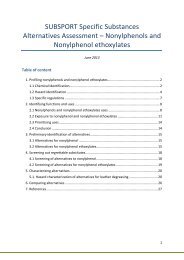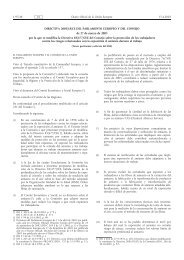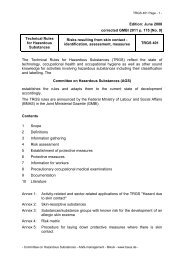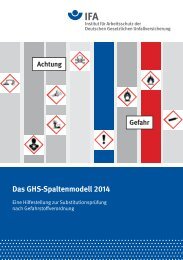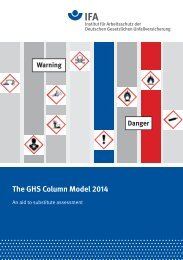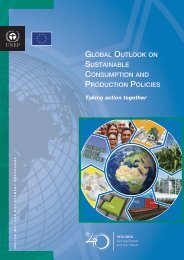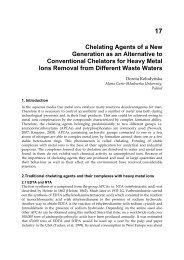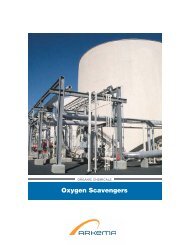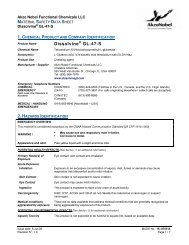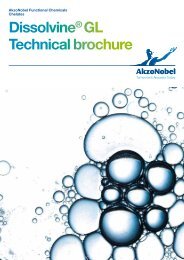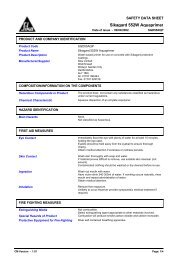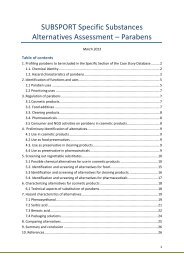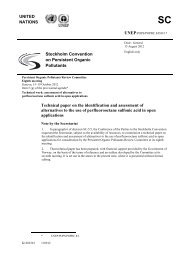(English (US)) HEMPEL SDS GHS_CLP - Subsport
(English (US)) HEMPEL SDS GHS_CLP - Subsport
(English (US)) HEMPEL SDS GHS_CLP - Subsport
- TAGS
- hempel
- subsport
- subsport.eu
You also want an ePaper? Increase the reach of your titles
YUMPU automatically turns print PDFs into web optimized ePapers that Google loves.
1.1 Product identifier<br />
Safety Data Sheet<br />
<strong>HEMPEL</strong>'S PAINT STRIPPER 99540<br />
Conforms to Regulation (EC) No. 1907/2006 (REACH), Annex II. - Denmark<br />
SECTION 1: Identification of the substance/mixture and of the company/undertaking<br />
Product identity : 9954000000<br />
Precautionary statements : cleaner<br />
1.2 Relevant identified uses of the substance or mixture and uses advised against<br />
Field of application : yacht.<br />
Identified uses : Consumer applications.<br />
1.3 Details of the supplier of the safety data sheet<br />
<strong>HEMPEL</strong> A/S<br />
Lundtoftevej 150<br />
DK-2800 Kgs. Lyngby<br />
Denmark<br />
Tel.: + 45 45 93 38 00<br />
hempel@hempel.com<br />
Date of issue : 20 May 2012<br />
Date of previous issue :<br />
24 April 2012.<br />
SECTION 2: Hazards identification<br />
2.1 Classification of the substance or mixture<br />
Product definition : Mixture<br />
Classification according to Directive 1999/45/EC [DPD]<br />
<strong>HEMPEL</strong>'S PAINT STRIPPER 99540 Product name :<br />
The product is classified as dangerous according to Directive 1999/45/EC and its amendments.<br />
Classification :<br />
F; R11<br />
R52/53<br />
Physical/chemical hazards : Highly flammable.<br />
Emergency telephone number (with hours of operation)Company deta<br />
+45 45 93 38 00 (08.00 - 17.00)<br />
See section 4 First aid measures.<br />
Environmental hazards : Harmful to aquatic organisms, may cause long-term adverse effects in the aquatic environment.<br />
2.2 Label elements<br />
Hazard symbol or symbols :<br />
Indication of danger : Highly flammable<br />
Risk phrases :<br />
Hazardous ingredients : Not applicable.<br />
Special packaging requirements<br />
Containers to be fitted with childresistant<br />
fastenings :<br />
Not applicable.<br />
Tactile warning of danger : Yes, applicable.<br />
R11- Highly flammable.<br />
R52/53- Harmful to aquatic organisms, may cause long-term adverse effects in the aquatic<br />
environment.<br />
Safety phrases : S2- Keep out of the reach of children.<br />
S46- If swallowed, seek medical advice immediately and show this container or label.<br />
Date of issue: May 2012<br />
-<br />
Page: 1/10<br />
Safety Data Sheet
SECTION 3: Composition/information on ingredients<br />
Substances presenting a health or environmental hazard within the meaning of the Dangerous Substances Directive 67/548/EEC or<br />
assigned an occupational exposure limit or PBT or vPvB.<br />
1,3-Dioxolane EC: 211-463-5<br />
CAS: 646-06-0<br />
Index: 605-017-00-2<br />
dimethoxymethane EC: 203-714-2<br />
CAS: 109-87-5<br />
isopropanol EC: 200-661-7<br />
CAS: 67-63-0<br />
Index: 603-117-00-0<br />
solvent naphtha (petroleum),<br />
light arom.<br />
EC: 265-199-0<br />
CAS: *64742-95-6<br />
Index: 649-356-00-4<br />
methanol EC: 200-659-6<br />
CAS: 67-56-1<br />
Index: 603-001-00-X<br />
See Section 16 for the full<br />
text of the R-phrases<br />
declared above.<br />
Regulation (EC) No. 1272/2008 [<strong>CLP</strong>]<br />
50-75 F; R11 FLAMMABLE LIQUIDS - Category 2 [2]<br />
25-35 F; R11 FLAMMABLE LIQUIDS - Category 2 [2]<br />
5-10 F; R11<br />
Xi; R36<br />
R67<br />
3-5 Xn; R20, R65<br />
Xi; R36/37/38<br />
N; R51/53<br />
SECTION 4: First aid measures<br />
Inhalation :<br />
Skin contact : Remove contaminated clothing and shoes. Wash skin thoroughly with soap and water or use<br />
recognized skin cleanser. Do NOT use solvents or thinners.<br />
Ingestion :<br />
Notes to physician : Not applicable.<br />
Specific treatments :<br />
9954000000<br />
Remove to fresh air. Keep person warm and at rest. If not breathing, if breathing is irregular or if<br />
respiratory arrest occurs, provide artificial respiration or oxygen by trained personnel. Give nothing by<br />
mouth. If unconscious, place in recovery position and seek medical advice.<br />
Protection of first-aiders : No action shall be taken involving any personal risk or without suitable training. It may be dangerous to<br />
the person providing aid to give mouth-to-mouth resuscitation.<br />
4.2 Most important symptoms and effects, both acute and delayed<br />
Potential acute health effects<br />
Eye contact :<br />
Inhalation :<br />
Skin contact :<br />
Ingestion :<br />
Over-exposure signs/symptoms<br />
Eye contact :<br />
Inhalation :<br />
Skin contact :<br />
Ingestion :<br />
If swallowed, seek medical advice immediately and show this container or label. Keep person warm and<br />
at rest. Do not induce vomiting unless directed to do so by medical personnel. Lower the head so that<br />
vomit will not re-enter the mouth and throat.<br />
May cause eye irritation.<br />
No known significant effects or critical hazards.<br />
May cause skin irritation.<br />
No known significant effects or critical hazards.<br />
No specific data.<br />
No specific data.<br />
No specific data.<br />
No specific data.<br />
4.3 Indication of any immediate medical attention and special treatment needed<br />
SECTION 5: Firefighting measures<br />
5.1 Extinguishing media<br />
Extinguishing media :<br />
Hazards from the substance or<br />
mixture :<br />
Hazardous combustion products :<br />
No specific treatment.<br />
5.2 Special hazards arising from the substance or mixture<br />
5.3 Advice for firefighters<br />
Recommended: alcohol resistant foam, CO2, powders, water spray.<br />
Not to be used: waterjet.<br />
Highly flammable liquid. In a fire or if heated, a pressure increase will occur and the container may<br />
burst, with the risk of a subsequent explosion. Runoff to sewer may create fire or explosion hazard.<br />
Decomposition products may include the following materials: carbon oxides<br />
Promptly isolate the scene by removing all persons from the vicinity of the incident if there is a fire. No action shall be taken involving any<br />
personal risk or without suitable training. Fire will produce dense black smoke. Exposure to decomposition products may cause a health<br />
hazard. Cool closed containers exposed to fire with water. Do not release runoff from fire to drains or watercourses. Fire-fighters should<br />
wear appropriate protective equipment and self-contained breathing apparatus (SCBA) with a full face-piece operated in positive pressure<br />
mode. Clothing for fire-fighters (including helmets, protective boots and gloves) conforming to European standard EN 469 will provide a<br />
basic level of protection for chemical incidents.<br />
SECTION 6: Accidental release measures<br />
6.1 Personal precautions, protective equipment and emergency procedures<br />
Exclude sources of ignition and be aware of explosion hazard. Ventilate the area. Avoid breathing vapor or mist. Refer to protective<br />
measures listed in sections 7 and 8. No action shall be taken involving any personal risk or without suitable training. If the product<br />
contaminates lakes, rivers, or sewers, inform the appropriate authorities in accordance with local regulations.<br />
6.2 Environmental precautions<br />
Avoid dispersal of spilled material and runoff and contact with soil, waterways, drains and sewers. Inform the relevant authorities if the<br />
product has caused environmental pollution (sewers, waterways, soil or air). Water polluting material.<br />
Date of issue: May 2012<br />
-<br />
Page: 3/10<br />
Safety Data Sheet
SECTION 6: Accidental release measures<br />
6.3 Methods and materials for containment and cleaning up<br />
9954000000<br />
Stop leak if without risk. Move containers from spill area. Approach release from upwind. Prevent entry into sewers, water courses,<br />
basements or confined areas. Wash spillages into an effluent treatment plant or proceed as follows. Contain and collect spillage with noncombustible,<br />
absorbent material e.g. sand, earth, vermiculite or diatomaceous earth and place in container for disposal according to local<br />
regulations (see section 13). Use spark-proof tools and explosion-proof equipment. Contaminated absorbent material may pose the same<br />
hazard as the spilled product.<br />
6.4 Reference to other sections<br />
See Section 1 for emergency contact information.<br />
See Section 8 for information on appropriate personal protective equipment.<br />
See Section 13 for additional waste treatment information.<br />
SECTION 7: Handling and storage<br />
7.1 Precautions for safe handling<br />
Vapors are heavier than air and may spread along floors. Vapors may form explosive mixtures with air. Prevent the creation of flammable or<br />
explosive concentrations of vapors in air and avoid vapor concentrations higher than the occupational exposure limits. In addition, the<br />
product should be used only in areas from which all naked lights and other sources of ignition have been excluded. Electrical equipment<br />
should be protected to the appropriate standard. To dissipate static electricity during transfer, ground drum and connect to receiving<br />
container with bonding strap. No sparking tools should be used.<br />
Avoid inhalation of vapour, dust and spray mist. Avoid contact with skin and eyes. Eating, drinking and smoking should be prohibited in area<br />
where this material is handled, stored and processed. Appropriate personal protective equipment: see Section 8. Always keep in containers<br />
made from the same material as the original one.<br />
7.2 Conditions for safe storage, including any incompatibilities<br />
Store in accordance with local regulations for flammable liquids. Store in a cool, well-ventilated area away from incompatible materials and<br />
ignition sources. Keep out of the reach of children. Keep away from: Oxidizing agents, strong alkalis, strong acids. No smoking. Prevent<br />
unauthorized access. Containers that are opened must be carefully resealed and kept upright to prevent leakage.<br />
Storage : Do not store below the following temperature: 5 °C<br />
7.3 Specific end use(s)<br />
See separate Product Data Sheet for recommendations or industrial sector specific solutions.<br />
SECTION 8: Exposure controls/personal protection<br />
8.1 Control parameters<br />
Product/ingredient name Exposure limit values<br />
1,3-Dioxolane EU OEL (Europe, 2/2010).<br />
(ACGIH) TWA: 20 ppm 8 hour(s).<br />
dimethoxymethane Arbejdstilsynet (Denmark, 3/2008).<br />
TWA: 3100 mg/m³ 8 hour(s).<br />
TWA: 1000 ppm 8 hour(s).<br />
isopropanol Arbejdstilsynet (Denmark, 3/2008). Absorbed through skin.<br />
TWA: 490 mg/m³ 8 hour(s).<br />
TWA: 200 ppm 8 hour(s).<br />
solvent naphtha (petroleum), light arom. Arbejdstilsynet (Denmark, 1/2001).<br />
TWA: 25 ppm 8 hour(s). Form:<br />
TWA: 120 mg/m³ 8 hour(s). Form:<br />
methanol Arbejdstilsynet (Denmark, 3/2008). Absorbed through skin.<br />
TWA: 260 mg/m³ 8 hour(s).<br />
TWA: 200 ppm 8 hour(s).<br />
Recommended monitoring procedures<br />
If this product contains ingredients with exposure limits, personal, workplace atmosphere or biological monitoring may be required to<br />
determine the effectiveness of the ventilation or other control measures and/or the necessity to use respiratory protective equipment.<br />
Reference should be made to European Standard EN 689 for methods for the assessment of exposure by inhalation to chemical agents and<br />
national guidance documents for methods for the determination of hazardous substances.<br />
Derived effect levels<br />
No DELs available.<br />
Predicted effect concentrations<br />
No PECs available.<br />
Date of issue: May 2012<br />
-<br />
Page: 4/10<br />
Safety Data Sheet
SECTION 8: Exposure controls/personal protection<br />
8.2 Exposure controls<br />
Appropriate engineering controls<br />
Eye/face protection :<br />
Hand protection :<br />
Respiratory protection :<br />
Environmental exposure controls<br />
9954000000<br />
Arrange sufficient ventilation by local exhaust ventilation and good general ventilation to keep the airborne concentrations of vapors or dust<br />
lowest possible and below their respective threshold limit value. Ensure that eyewash stations and safety showers are proximal to the workstation<br />
location.<br />
Individual protection measures<br />
General : Gloves must be worn for all work that may result in soiling. Apron/coveralls/protective clothing must be<br />
worn when soiling is so great that regular work clothes do not adequately protect skin against contact<br />
with the product. Safety eyewear should be used when there is a likelihood of exposure.<br />
Hygiene measures :<br />
Body protection :<br />
Where personal protection equipment is required this shall be chosen in accordance with Danish<br />
Working Environment Services Executive Order no. 302/1993. See product Code Number (section 15).<br />
Wash hands, forearms, and face thoroughly after handling compounds and before eating, smoking,<br />
using lavatory, and at the end of day.<br />
Safety eyewear complying with an approved standard should be used when a risk assessment indicates<br />
this is necessary to avoid exposure to liquid splashes, mists or dusts.<br />
Wear chemical-resistant gloves (tested to EN374) in combination with 'basic' employee training. The<br />
quality of the chemical-resistant protective gloves must be chosen as a function of the specific<br />
workplace concentrations and quantity of hazardous substances.<br />
Since the actual work situation is unknown. Supplier of gloves should be contacted in order to find the<br />
appropriate type. Below listed glove(s) should be regarded as generic advice:<br />
Recommended: Silver Shield / 4H gloves, nitrile rubber, butyl rubber, polyvinyl alcohol (PVA), Viton®<br />
May be used: neoprene rubber, natural rubber (latex), polyvinyl chloride (PVC)<br />
Personal protective equipment for the body should be selected based on the task being performed and<br />
the risks involved handling this product.<br />
If working areas have insufficient ventilation: When the product is applied by means that will not<br />
generate an aerosol such as, brush or roller wear half or totally covering mask equipped with gas filter<br />
of type A, when grinding use particle filter of type P. Be sure to use an approved/certified respirator or<br />
equivalent.<br />
This product contains low-boiling point liquids. Any respiratory protective equipment should be<br />
air-fed.<br />
Emissions from ventilation or work process equipment should be checked to ensure they comply with the requirements of environmental<br />
protection legislation. In some cases, fume scrubbers, filters or engineering modifications to the process equipment will be necessary to<br />
reduce emissions to acceptable levels.<br />
SECTION 9: Physical and chemical properties<br />
9.1 Information on basic physical and chemical properties<br />
Physical state :<br />
Odor :<br />
pH :<br />
Melting point/freezing point :<br />
Boiling point/boiling range :<br />
Flash point :<br />
Evaporation rate :<br />
Upper/lower flammability or<br />
explosive limits :<br />
Vapor pressure :<br />
Vapor density :<br />
Relative density :<br />
Solubility(ies) :<br />
Partition coefficient (LogKow) :<br />
Auto-ignition temperature :<br />
Liquid.<br />
Solvent-like<br />
-95.15°C This is based on data for the following ingredient: 1,3-Dioxolane<br />
Testing not relevant or not possible due to nature of the product.<br />
Flammability : Highly flammable in the presence of the following materials or conditions: open flames, sparks and<br />
static discharge, heat and oxidizing materials.<br />
Slightly flammable in the presence of the following materials or conditions: reducing materials.<br />
Date of issue: May 2012<br />
-<br />
Testing not relevant or not possible due to nature of the product.<br />
Closed cup: -9°C (15.8°F)<br />
Testing not relevant or not possible due to nature of the product.<br />
0.5 - 44 vol %<br />
9.33 kPa This is based on data for the following ingredient: 1,3-Dioxolane<br />
Testing not relevant or not possible due to nature of the product.<br />
0.961 g/cm 3<br />
Easily soluble in the following materials: cold water and hot water.<br />
Testing not relevant or not possible due to nature of the product.<br />
Testing not relevant or not possible due to nature of the product.<br />
Page: 5/10<br />
Safety Data Sheet
SECTION 9: Physical and chemical properties<br />
Decomposition temperature :<br />
Viscosity :<br />
Explosive properties :<br />
Oxidizing properties :<br />
9.2 Other information<br />
Solvent(s) % by weight :<br />
Testing not relevant or not possible due to nature of the product.<br />
Explosive in the presence of the following materials or conditions: open flames, sparks and static<br />
discharge, heat and oxidizing materials.<br />
Weighted average: 96 %<br />
Water % by weight : Weighted average: 2 %<br />
VOC content : 922.4 g/l<br />
TOC Content : Weighted average: 428 g/l<br />
Solvent Gas : Weighted average: 0.305 m 3 /l<br />
SECTION 10: Stability and reactivity<br />
10.1 Reactivity<br />
10.2 Chemical stability<br />
The product is stable.<br />
10.3 Possibility of hazardous reactions<br />
10.4 Conditions to avoid<br />
10.5 Incompatible materials<br />
10.6 Hazardous decomposition products<br />
Testing not relevant or not possible due to nature of the product.<br />
Testing not relevant or not possible due to nature of the product.<br />
No specific test data related to reactivity available for this product or its ingredients.<br />
Under normal conditions of storage and use, hazardous reactions will not occur.<br />
Highly reactive or incompatible with the following materials: oxidizing materials and acids.<br />
Reactive or incompatible with the following materials: reducing materials, organic materials and alkalis.<br />
When exposed to high temperatures (i.e. in case of fire) harmful decomposition products may be formed:<br />
Decomposition products may include the following materials: carbon oxides<br />
9954000000<br />
Avoid all possible sources of ignition (spark or flame). Do not pressurize, cut, weld, braze, solder, drill, grind or expose containers to heat or<br />
sources of ignition.<br />
SECTION 11: Toxicological information<br />
11.1 Information on toxicological effects<br />
Exposure to component solvent vapor concentrations may result in adverse health effects such as mucous membrane and respiratory<br />
system irritation and adverse effects on the kidneys, liver and central nervous system. Solvents may cause some of the above effects by<br />
absorption through the skin. Symptoms and signs include headaches, dizziness, fatigue, muscular weakness, drowsiness and, in extreme<br />
cases, loss of consciousness. Repeated or prolonged contact with the preparation may cause removal of natural fat from the skin, resulting<br />
in non-allergic contact dermatitis and absorption through the skin. If splashed in the eyes, the liquid may cause irritation and reversible<br />
damage. Accidental swallowing may cause stomach pain. Chemical lung inflammation may occur if the product is taken into the lungs via<br />
vomiting.<br />
Acute toxicity<br />
Product/ingredient name Result Species Dose Exposure<br />
1,3-Dioxolane LC50 Inhalation Vapor Rat 20650 mg/m3 4 hours<br />
LD50 Dermal Rabbit 15000 mg/kg -<br />
LD50 Oral Rat 3 g/kg -<br />
dimethoxymethane LD50 Oral Rat 6653 mg/kg -<br />
isopropanol LD50 Dermal Rabbit 12800 mg/kg -<br />
LD50 Intraperitoneal Rabbit 667 mg/kg -<br />
LD50 Oral Rat 5000 mg/kg -<br />
LDLo Oral Human 3570 mg/kg -<br />
solvent naphtha (petroleum), light<br />
arom.<br />
LD50 Dermal Rabbit >2000 mg/kg -<br />
LD50 Oral Rat 8400 mg/kg -<br />
methanol LC50 Inhalation Gas. Rat 64000 ppm 4 hours<br />
Date of issue: May 2012<br />
-<br />
Page: 6/10<br />
Safety Data Sheet
SECTION 11: Toxicological information<br />
methanol LC50 Inhalation Gas. Rat 64000 ppm 4 hours<br />
LD50 Dermal Rabbit 15800 mg/kg -<br />
Acute toxicity estimates<br />
Oral 5639.1 mg/kg<br />
Dermal 16917.3 mg/kg<br />
Inhalation (vapors) 98.48 mg/l<br />
Irritation/Corrosion<br />
1,3-Dioxolane Skin - Mild irritant Rabbit - 0.5 Mililiters<br />
dimethoxymethane Eyes - Moderate irritant Rabbit - 100 microliters<br />
isopropanol Eyes - Moderate irritant Rabbit - 24 hours 100 milligrams<br />
Skin - Mild irritant Rabbit - 500 milligrams<br />
solvent naphtha (petroleum), light Eyes - Mild irritant Rabbit - 24 hours 100 microliters<br />
arom.<br />
Product/ingredient name Result Species Score Exposure<br />
methanol Eyes - Moderate irritant Rabbit - 24 hours 100 milligrams<br />
Skin - Moderate irritant Rabbit - 24 hours 20 milligrams<br />
Information on the likely routes of exposure<br />
Routes of entry anticipated: Oral, Dermal, Inhalation.<br />
Potential chronic health effects<br />
Route ATE value<br />
Other information : No additional known significant effects or critical hazards.<br />
SECTION 12: Ecological information<br />
12.1 Toxicity<br />
Do not allow to enter drains or watercourses. Harmful to aquatic organisms, may cause long-term adverse effects in the aquatic<br />
environment.<br />
Product/ingredient name Result Exposure<br />
Species<br />
1,3-Dioxolane Acute EC50 6950000 ug/L Fresh water Daphnia - Daphnia magna - 1 - 3 days 48 hours<br />
Acute LC50 10000000 ug/L Marine water Fish - Cyprinodon variegatus 96 hours<br />
dimethoxymethane Acute LC50 6990000 ug/L Fresh water Fish - Pimephales promelas - 29 - 31<br />
days - 19.6 mm - 0.102 g<br />
96 hours<br />
isopropanol Acute LC50 1400000 - 1950000 ug/L Marine<br />
water<br />
Crustaceans - Crangon crangon 48 hours<br />
Acute LC50 >1400000 ug/L Fish - Gambusia affinis - 20 - 30 mm 96 hours<br />
solvent naphtha (petroleum), light Acute EC50 19 mg/l Algae - Pseudokirchneriella subcapitata 96 hours<br />
arom.<br />
(green algae)<br />
Acute EC50 6.14 mg/l Daphnia - Daphnia magna 48 hours<br />
Acute LC50 9.22 mg/l Fish - Oncorhynchus mykiss (rainbow<br />
trout)<br />
96 hours<br />
methanol Acute EC50 16.912 mg/L Marine water Algae - Ulva pertusa 96 hours<br />
Acute LC50 2500000 ug/L Marine water Crustaceans - Crangon crangon - Adult 48 hours<br />
Acute LC50 3289 - 4395 mg/L Fresh water Daphnia - Daphnia magna - Neonate -<br />
100000 ug/L Fresh water Fish - Pimephales promelas - Juvenile<br />
(Fledgling, Hatchling, Weanling) - 0.2 -<br />
0.5 g<br />
96 hours<br />
12.2 Persistence and degradability<br />
Product/ingredient name Test Result Dose<br />
Inoculum<br />
solvent naphtha (petroleum), light<br />
arom.<br />
Product/ingredient name Aquatic half-life Photolysis Biodegradability<br />
solvent naphtha (petroleum), light<br />
arom.<br />
12.3 Bioaccumulative potential<br />
Product/ingredient name<br />
Date of issue: May 2012<br />
-<br />
- >70 % - Readily - 28 days - -<br />
- - Readily<br />
Page: 7/10<br />
LogPow BCF Potential<br />
Safety Data Sheet<br />
9954000000
SECTION 12: Ecological information<br />
1,3-Dioxolane -0.37 - low<br />
dimethoxymethane 0 - low<br />
isopropanol 0.05 - low<br />
methanol -0.82 - 0.66 - low<br />
12.4 Mobility in soil<br />
Soil/water partition coefficient<br />
(KOC) :<br />
Mobility :<br />
12.5 Results of PBT and vPvB assessment<br />
PBT : Not applicable.<br />
vPvB : Not applicable.<br />
12.6 Other adverse effects<br />
No known significant effects or critical hazards.<br />
SECTION 13: Disposal considerations<br />
13.1 Waste treatment methods<br />
European waste catalogue no. (EWC) is given below.<br />
European waste catalogue (EWC) : 08 01 11*<br />
Packaging<br />
No known data avaliable in our database.<br />
No known data avaliable in our database.<br />
The generation of waste should be avoided or minimized wherever possible.<br />
Residues of the product is listed as hazardous waste. Dispose of according to all state and local applicable regulations.<br />
Spillage, remains, discarded clothes and similar should be discarded in a fireproof container.<br />
Spillage, remains, empty cans, discarded working clothes and disposable towels shall be discarded in a special container that must be<br />
marked with the contents. E.g. "Farligt affald. Pas på!"<br />
9954000000<br />
The generation of waste should be avoided or minimized wherever possible. Waste packaging should be recycled. Incineration or landfill<br />
should only be considered when recycling is not feasible.<br />
SECTION 14: Transport information<br />
Transport may take place according to national regulation or ADR for transport by road, RID for transport by train, IMDG for transport by<br />
sea, IATA for transport by air.<br />
Transport within user’s premises: always transport in closed containers that are upright and secure. Ensure that persons transporting the<br />
product know what to do in the event of an accident or spillage.<br />
ADR/RID<br />
Class<br />
IMDG<br />
Class<br />
IATA<br />
Class<br />
14.7 Transport in bulk according to Annex II of MARPOL 73/78 and the IBC Code<br />
Not applicable.<br />
14.1<br />
UN no.<br />
UN1263<br />
UN1263<br />
14.2<br />
Proper shipping name<br />
PAINT RELATED MATERIAL<br />
14.3<br />
14.4 14.5<br />
Transport hazard class(es) PG* Env* Additional information<br />
PAINT RELATED MATERIAL 3 III<br />
3<br />
UN1263 PAINT RELATED MATERIAL 3 II No. Remarks<br />
The "viscosity exemption"<br />
provisions do not apply to air<br />
transport.<br />
PG* : Packing group<br />
Env.* : Environmental hazards<br />
14.6 Special precautions for user<br />
Not available.<br />
Date of issue: May 2012<br />
-<br />
Page: 8/10<br />
III<br />
No.<br />
No.<br />
Special provisions<br />
640 (E)<br />
Tunnel code<br />
(D/E)<br />
Emergency schedules<br />
(EmS)<br />
F-E, S-E<br />
Safety Data Sheet
SECTION 15: Regulatory information<br />
15.1 Safety, health and environmental regulations/legislation specific for the substance or mixture<br />
Annex XVII - Restrictions on the manufacture, placing on the market and use of certain dangerous substances, mixtures and articles<br />
Not applicable.<br />
Other EU regulations<br />
National regulations<br />
9954000000<br />
EU Regulation (EC) No. 1907/2006 (REACH) Annex XIV - List of substances subject to authorization - Substances of very high concern<br />
None of the components are listed.<br />
Seveso category : 7b.<br />
Detergents - Regulation (EC) No 907/2006<br />
Contains (EU Detergents<br />
Regulation) :<br />
Product registration number : 1911421<br />
Danish fire class :<br />
MAL-code :<br />
Low-boiling liquids : This product contains low-boiling point liquids. Any respiratory protective equipment should be air-fed.<br />
List of undesirable substances : Listed<br />
Waste card number : 03.21<br />
Waste group : C<br />
15.2 Chemical Safety Assessment<br />
less than 5%: aromatic hydrocarbons, disinfectants.<br />
I - 1<br />
5-3<br />
MAL-number : 3368<br />
Restrictions on use : Not to be used by professional users below 18 years of age. See the National Working Environment<br />
Authorities Executive Order on young people's dangerous work.<br />
This product contains substances for which Chemical Safety Assessments are still required.<br />
SECTION 16: Other information<br />
Indicates information that has changed from previously issued version.<br />
Abbreviations and acronyms : ATE = Acute Toxicity Estimate<br />
<strong>CLP</strong> = Classification, Labelling and Packaging Regulation [Regulation (EC) No. 1272/2008]<br />
DNEL = Derived No Effect Level<br />
EUH statement = <strong>CLP</strong>-specific Hazard statement<br />
PNEC = Predicted No Effect Concentration<br />
RRN = REACH Registration Number<br />
Full text of abbreviated R phrases :<br />
Full text of classifications [DSD/DPD] : F - Highly flammable<br />
T - Toxic<br />
Xn - Harmful<br />
Xi - Irritant<br />
N - Dangerous for the environment<br />
Classification according to Regulation (EC) No. 1272/2008 [<strong>CLP</strong>/<strong>GHS</strong>]<br />
Hazard pictograms :<br />
Signal word :<br />
Date of issue: May 2012<br />
-<br />
R11- Highly flammable.<br />
R23/24/25- Toxic by inhalation, in contact with skin and if swallowed.<br />
R39/23/24/25- Toxic: danger of very serious irreversible effects through inhalation, in contact with skin and if<br />
swallowed.<br />
R20- Harmful by inhalation.<br />
R65- Harmful: may cause lung damage if swallowed.<br />
R36- Irritating to eyes.<br />
R36/37/38- Irritating to eyes, respiratory system and skin.<br />
R67- Vapors may cause drowsiness and dizziness.<br />
R51/53- Toxic to aquatic organisms, may cause long-term adverse effects in the aquatic environment.<br />
R52/53- Harmful to aquatic organisms, may cause long-term adverse effects in the aquatic environment.<br />
Danger<br />
Page: 9/10<br />
Safety Data Sheet
SECTION 16: Other information<br />
Hazard statements :<br />
Notice to reader<br />
Extremely flammable liquid and vapor.<br />
Causes serious eye irritation.<br />
Harmful to aquatic life with long lasting effects.<br />
Procedure used to derive the classification according to Regulation (EC) No. 1272/2008 [<strong>CLP</strong>/<strong>GHS</strong>]<br />
Classification Justification<br />
FLAMMABLE LIQUIDS - Category 1 On basis of test data<br />
SERIO<strong>US</strong> EYE DAMAGE/ EYE IRRITATION - Category 2 Calculation method<br />
AQUATIC TOXICITY (CHRONIC) - Category 3 Calculation method<br />
9954000000<br />
The information contained in this safety data sheet is based on the present state of knowledge and EU and national legislation. It provides<br />
guidance on health, safety and environmental aspects for handling the product in a safe way and should not be construed as any guarantee<br />
of the technical preformance or suitability for particular applications.<br />
It is always the duty of the user/employer to ascertain that the work is planned and carried out in accordance with the national regulations.<br />
Date of issue: May 2012<br />
-<br />
Page: 10/10<br />
Safety Data Sheet




